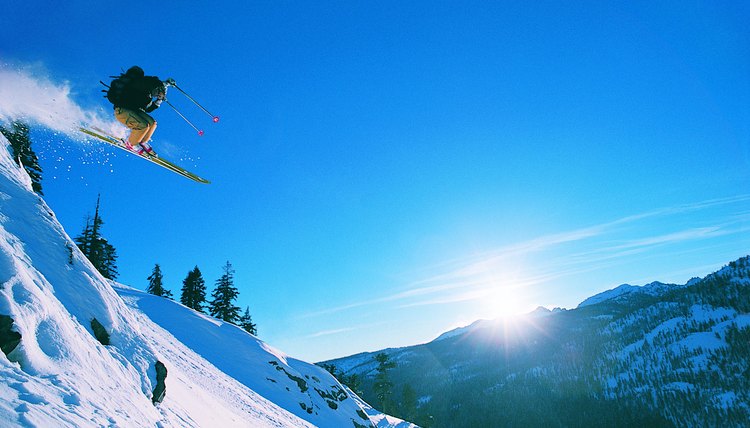Why Do I Have Pain in My Upper Thigh When Downhill Skiing?

Skiers use several muscle groups when going downhill. The hip flexor, the tissue that connects the muscle to the bone, is particularly stressed during the activity, which increases the potential for developing iliopsoas syndrome or straining of the tendon. Because you raise and lower your legs and twist your hip while skiing, inflammation can easily occur. Most people will feel sore after the activity.
Muscles for Skiing
When you ski downhill, several muscles are activated such as the iliopsoas muscle, which is made up of the psoas and iliacus. These muscles work to flex your hip to bring your leg to the front of your body. The quadriceps, hamstrings and calves are also exercised when skiing downhill. The iliopsoas bursa is a tiny sac of fluid located between the hip joint and iliopsoas tendon. When you ski, the iliopsoas bursa can get irritated and inflamed, thereby leading to iliopsoas syndrome. Other parts of the body, such as your arms, shoulders and back, are also affected during skiing.
Pain When Skiing
The pain you feel in the upper thigh generally stems from the inflamed iliopsoas bursa. Because the iliopsoas muscle is attached to the thigh bone through the iliopsoas tendon, any irritation and pressure in the area can trigger pain responses in your upper thigh. The pain can be prevented by doing strength and conditioning exercises weeks before you start skiing. Ski according to your current level of expertise and training. Doing rotational and stretching exercises for 10 to 20 minutes before you ski downhill will help prevent inflammation and pain in the area.
Preventing the Pain
Perform strength exercises such as doing front and side planks for two to three sets at 30 seconds each then work your way to one full minute. Stretch the groin area and thighs by standing up then pulling one leg behind you. Grab your feet from behind using your hand then stretch for 10 seconds. Do the same for the other leg. Do body squats for three sets at 10 repetitions each. Keep your feet shoulder-width apart, then bend your knees to assume the squat position. Wear compression shorts to improve blood circulation to your legs.
References
Writer Bio
Vanessa Arellano Doctor has more than 10 years of professional writing experience, specializing in business and finance, health and fitness and general interest subjects. She has been published in the "Financial Times," "European Banking News Network," "Entrepreneur," Urbanette.com and WealthBriefing Asia.
